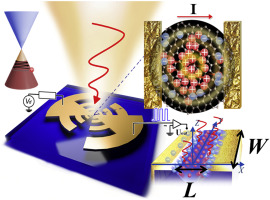Our official English website, www.x-mol.net, welcomes your
feedback! (Note: you will need to create a separate account there.)
Room-temperature photoconduction assisted by hot-carriers in graphene for sub-terahertz detection
Carbon ( IF 10.5 ) Pub Date : 2018-04-01 , DOI: 10.1016/j.carbon.2018.01.020 Changlong Liu , Lin Wang , Xiaoshuang Chen , Jing Zhou , Weida Hu , Xinran Wang , Jinhua Li , Zhiming Huang , Wei Zhou , Weiwei Tang , Gangyi Xu , Shao-Wei Wang , Wei Lu
Carbon ( IF 10.5 ) Pub Date : 2018-04-01 , DOI: 10.1016/j.carbon.2018.01.020 Changlong Liu , Lin Wang , Xiaoshuang Chen , Jing Zhou , Weida Hu , Xinran Wang , Jinhua Li , Zhiming Huang , Wei Zhou , Weiwei Tang , Gangyi Xu , Shao-Wei Wang , Wei Lu

|
Abstract The terahertz (THz) technique is still confronted with challenges partly due to lack of an efficient method to achieve sensitive detection at room temperature. Gapless graphene is highly sought-after as a potential candidate for active material in photo-detection across the whole electromagnetic spectrum. However, the efficient photo-to-electric conversions within THz range are not well-developed at present. Here we report the hot carrier-assisted photoconduction being triggered by a sub-THz electromagnetic wave in homogeneous graphene, which is beyond the conventional interband mechanism and can be potentially extended to the higher THz band. The photoconductive effect here is attributed to the additional carriers replenished from the electrode following the potential disturbance of the hot carrier diffusion, which depletes or increases the sheet density in the channel depending on the carrier-polarity in the channel. The biased photoconductive device shows sensitivity over 400 V/W (4 × 103 V/W) at room temperature and noise-equivalent power less than 0.5 nW/Hz0.5 (20 pW/Hz0.5) in reference to the incident (absorbed) power. The reported figures of merit represent the benchmark for further performance improvement via several different methods such as shortening the channel, using a matched antenna or material with improved mobility. All results presented open up the feasibility of achieving a photoconductive device for sensitive room temperature detection at terahertz frequencies.
中文翻译:

由石墨烯中的热载流子辅助的室温光导用于亚太赫兹检测
摘要 太赫兹 (THz) 技术仍然面临挑战,部分原因是缺乏一种在室温下实现灵敏检测的有效方法。无间隙石墨烯作为一种潜在的候选活性材料,在整个电磁光谱的光检测中备受追捧。然而,目前太赫兹范围内的高效光电转换还没有得到很好的发展。在这里,我们报告了由均质石墨烯中的亚太赫兹电磁波触发的热载流子辅助光电导,这超出了传统的带间机制,并且有可能扩展到更高的太赫兹波段。这里的光电导效应归因于在热载流子扩散的潜在干扰之后从电极补充的额外载流子,根据通道中的载流子极性,这会消耗或增加通道中的片密度。偏压光电导器件在室温下显示出超过 400 V/W (4 × 103 V/W) 的灵敏度和低于 0.5 nW/Hz0.5 (20 pW/Hz0.5) 的噪声等效功率(相对于入射(吸收) ) 力量。报告的品质因数代表了通过几种不同方法进一步提高性能的基准,例如缩短信道、使用匹配天线或具有改进移动性的材料。所呈现的所有结果开启了实现用于在太赫兹频率下进行灵敏室温检测的光电导器件的可行性。偏压光电导器件在室温下显示出超过 400 V/W (4 × 103 V/W) 的灵敏度和低于 0.5 nW/Hz0.5 (20 pW/Hz0.5) 的噪声等效功率(相对于入射(吸收) ) 力量。报告的品质因数代表了通过几种不同方法进一步提高性能的基准,例如缩短信道、使用匹配天线或具有改进移动性的材料。所呈现的所有结果开启了实现用于在太赫兹频率下进行灵敏室温检测的光电导器件的可行性。偏压光电导器件在室温下显示出超过 400 V/W (4 × 103 V/W) 的灵敏度和低于 0.5 nW/Hz0.5 (20 pW/Hz0.5) 的噪声等效功率(相对于入射(吸收) ) 力量。报告的品质因数代表了通过几种不同方法进一步提高性能的基准,例如缩短信道、使用匹配天线或具有改进移动性的材料。所呈现的所有结果开启了实现用于在太赫兹频率下进行灵敏室温检测的光电导器件的可行性。使用匹配的天线或具有改进移动性的材料。所呈现的所有结果开启了实现用于在太赫兹频率下进行灵敏室温检测的光电导器件的可行性。使用匹配的天线或具有改进移动性的材料。所呈现的所有结果开启了实现用于在太赫兹频率下进行灵敏室温检测的光电导器件的可行性。
更新日期:2018-04-01
中文翻译:

由石墨烯中的热载流子辅助的室温光导用于亚太赫兹检测
摘要 太赫兹 (THz) 技术仍然面临挑战,部分原因是缺乏一种在室温下实现灵敏检测的有效方法。无间隙石墨烯作为一种潜在的候选活性材料,在整个电磁光谱的光检测中备受追捧。然而,目前太赫兹范围内的高效光电转换还没有得到很好的发展。在这里,我们报告了由均质石墨烯中的亚太赫兹电磁波触发的热载流子辅助光电导,这超出了传统的带间机制,并且有可能扩展到更高的太赫兹波段。这里的光电导效应归因于在热载流子扩散的潜在干扰之后从电极补充的额外载流子,根据通道中的载流子极性,这会消耗或增加通道中的片密度。偏压光电导器件在室温下显示出超过 400 V/W (4 × 103 V/W) 的灵敏度和低于 0.5 nW/Hz0.5 (20 pW/Hz0.5) 的噪声等效功率(相对于入射(吸收) ) 力量。报告的品质因数代表了通过几种不同方法进一步提高性能的基准,例如缩短信道、使用匹配天线或具有改进移动性的材料。所呈现的所有结果开启了实现用于在太赫兹频率下进行灵敏室温检测的光电导器件的可行性。偏压光电导器件在室温下显示出超过 400 V/W (4 × 103 V/W) 的灵敏度和低于 0.5 nW/Hz0.5 (20 pW/Hz0.5) 的噪声等效功率(相对于入射(吸收) ) 力量。报告的品质因数代表了通过几种不同方法进一步提高性能的基准,例如缩短信道、使用匹配天线或具有改进移动性的材料。所呈现的所有结果开启了实现用于在太赫兹频率下进行灵敏室温检测的光电导器件的可行性。偏压光电导器件在室温下显示出超过 400 V/W (4 × 103 V/W) 的灵敏度和低于 0.5 nW/Hz0.5 (20 pW/Hz0.5) 的噪声等效功率(相对于入射(吸收) ) 力量。报告的品质因数代表了通过几种不同方法进一步提高性能的基准,例如缩短信道、使用匹配天线或具有改进移动性的材料。所呈现的所有结果开启了实现用于在太赫兹频率下进行灵敏室温检测的光电导器件的可行性。使用匹配的天线或具有改进移动性的材料。所呈现的所有结果开启了实现用于在太赫兹频率下进行灵敏室温检测的光电导器件的可行性。使用匹配的天线或具有改进移动性的材料。所呈现的所有结果开启了实现用于在太赫兹频率下进行灵敏室温检测的光电导器件的可行性。











































 京公网安备 11010802027423号
京公网安备 11010802027423号